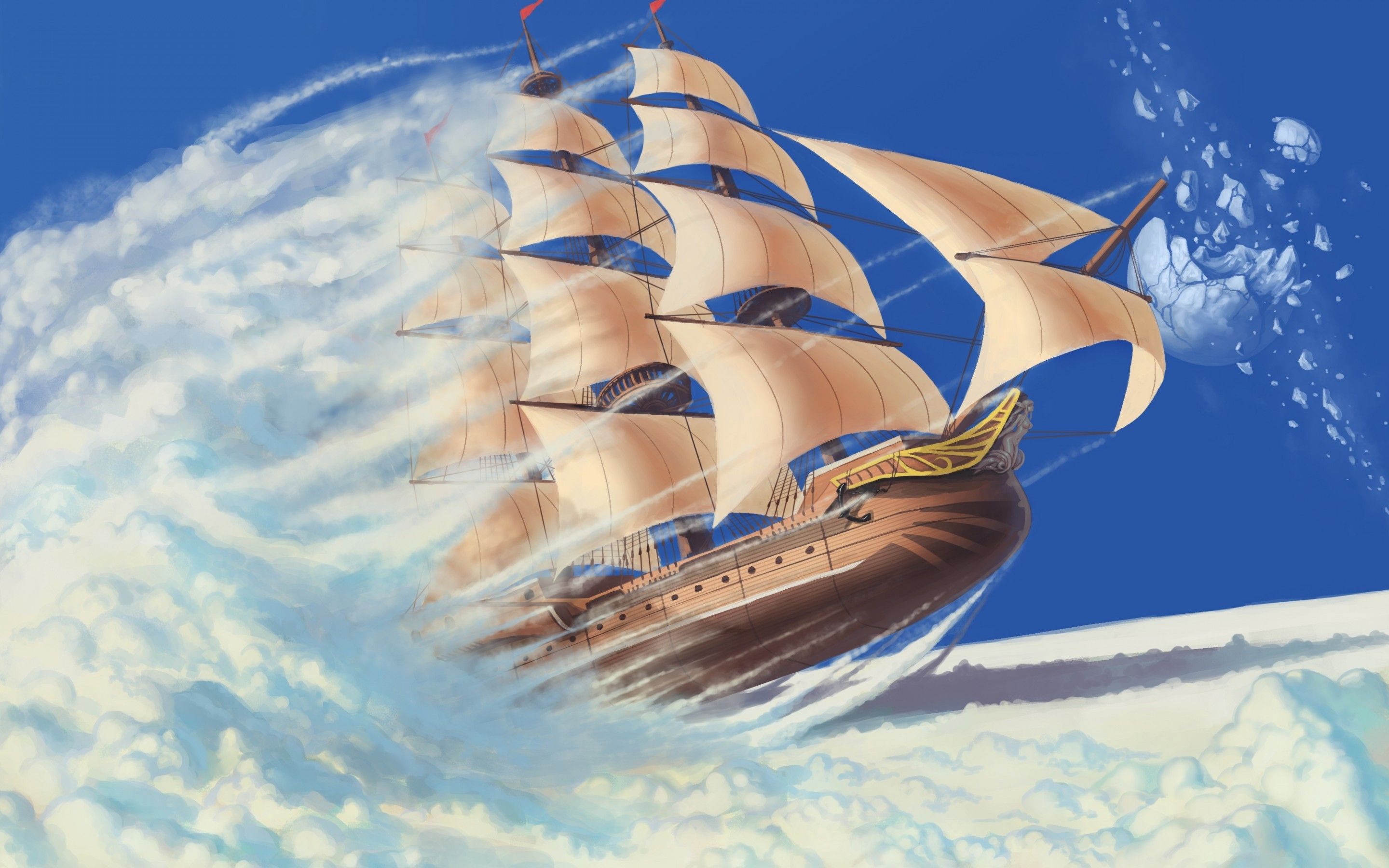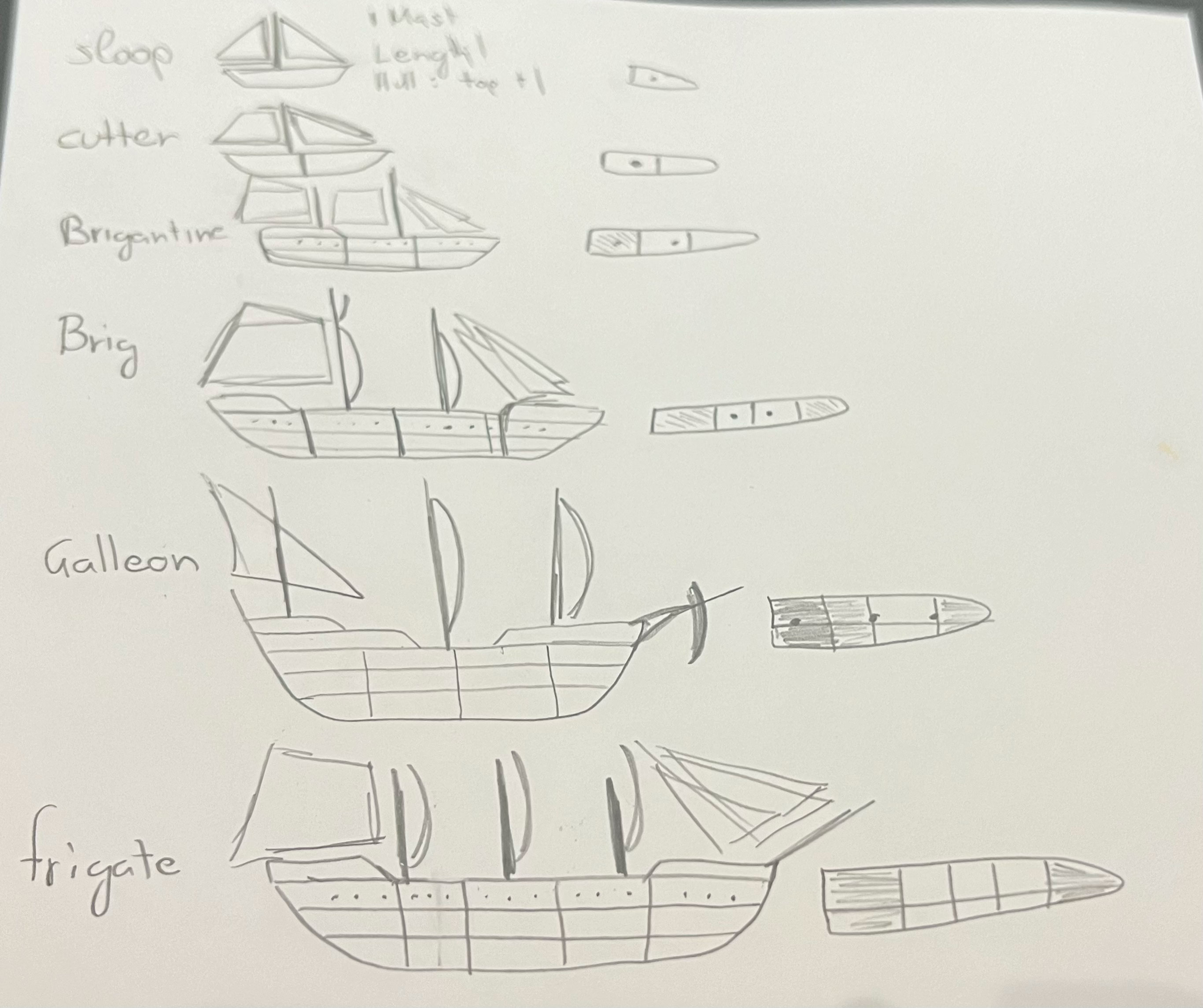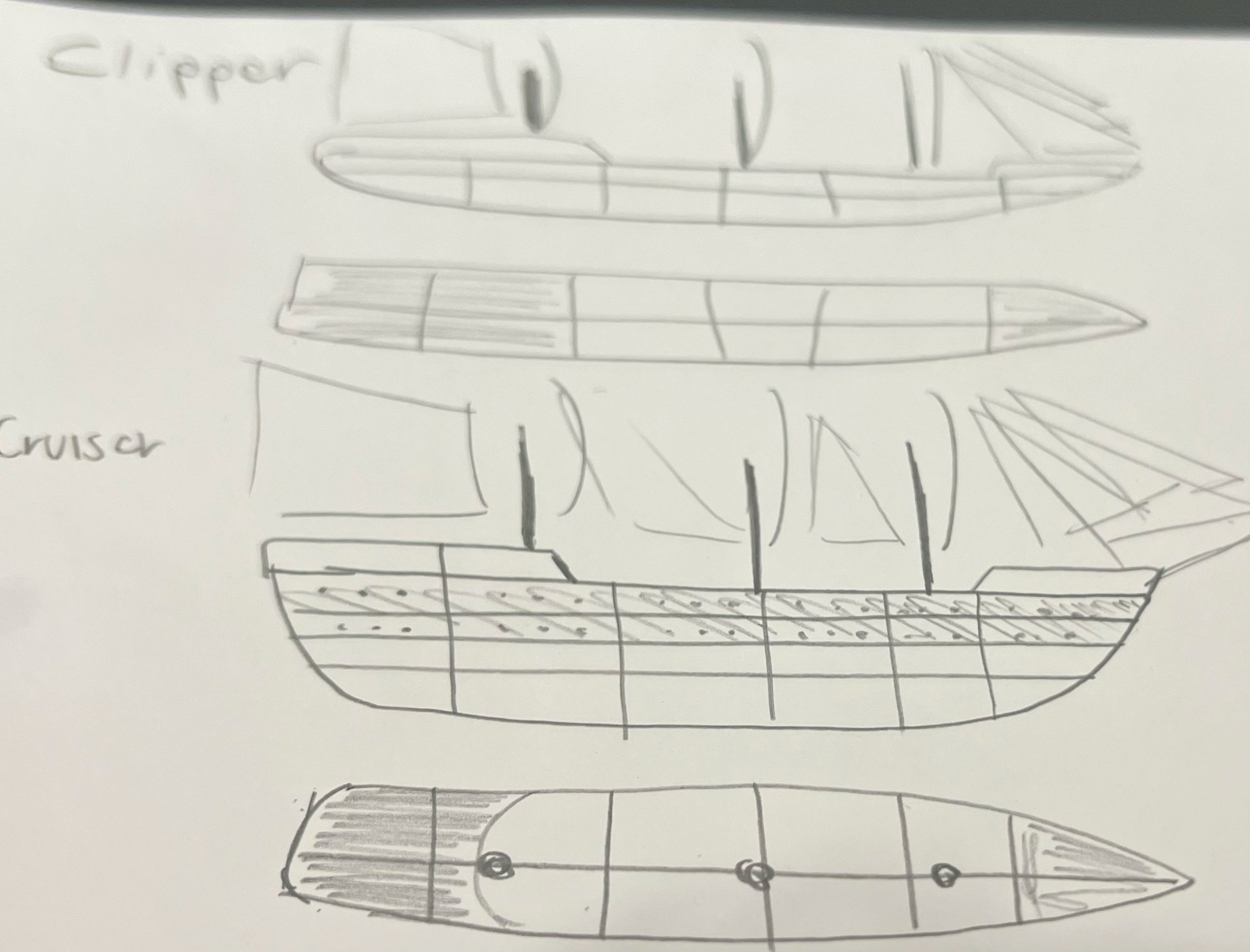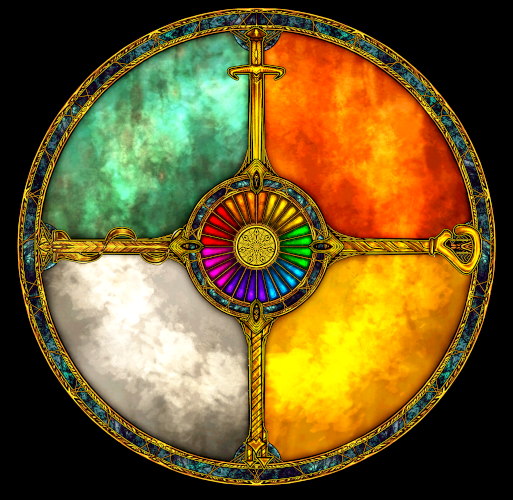Introduction to Etherships
What are Etherships?
Etherships or Airships are most commonly sailing ships that by making use of a magical device called the Ethercore and their sails can fly across the skies.How do they fly?
Levitatiion
Airships use of an Ether Crystal within a magical device called an Ether Core. Once an Ether core is charged with anima, it is able to levitate the ship above ground.
An Ether Crystal cannot make a ship fly (levitate and move at the same time). When the center of an Ether crystal is moved in any direction more than its radius it is automatically discharged and the object that it was holding in place falls.
That is where the Ether Core comes into play. An Ether Core makes sure that the crystal receives a steady current of anima so the moment is discharged it is charged again.
The Ether Core takes its energy from one or more Anima Banks hexagonal rods which serve as batteries. The Anima Banks themselves are charged and able to hold anima by a various devices.
An Anima Well connector, Temple Crystal, Anima Sails or Anima Antennas. Anima exists in different stages across the worlds of the multiverse so different devices might be necessary to capture it.
Where can I find an Ether Crystal
Ether crystals are found only in the lands that Etherium can be found, most commonly within the hearts of flying islands, since it's the charged Etherium that makes them fly.Travelling
Flying Up
Most Etherships use an Ethercore to achieve vertical thrust, by charging more or less their core. Not all airships have an Ethercore. Some just rely on lighter than air gases camptured in some sort of light container. An example of that are the raider ships of the Atarun, that make use of captured flying leviathan sack gases and temperature to achieve flight.The sky actually has a limit
In order for a structure to levitate it needs to be in contact with a charged ether crystal. The more you charge it the higher the crystal can levitate. Due to the physical properties of etherium no crystal can exceed a height of 1200m from sealevel(*). Charging a crystal more than that will cause it to explode. This creates in a way a "second shore" at that height. Which means that ships cannot reach above mountains of that height and that no flying island's centerpoint exists higher than that.Going places
Most airships make use of vertical sails and horizontal wings to ride the wind, but there are other that make use of giant fan-like oars or powered devices that work like flapping bird wings. Nations with more advanced knowledge of artifice and anima manipulation also use anima powered thrusters, commonly referred to as "brawlers" that are used most commonly to provide improved maneuverability or to significantly boost the speed of a ship. Continuous thrust using bruisers is very rare due to the immense anima requirements but in realms with abundance of anima like the Astral Ocean this is more than possible.To the Great Beyond
The only reason that was possible for the Ether Crystals to be dispersed by the young races across the verses was the discovery of the Rift Beacon or colloqually, the "Rifter". The Rifter is a device that is able to thread a dimensional rift and catapult a ship via a riftlane to another verse. Rifts drift continuesly and it takes an excellent navigator with deep understanding of anima and the laws governing a realm to find one. The drift is accelerated temporarily each time a ship passes through a rift which means that ships that pass with minutes difference through the same rift mind find themselves several kilometers away. In order for a navigator to even be able to detect a rift, they need to have a Versoscope, a complicated magical device that allows the navigator to psychically open her mind to the ebs and flows of the anima of a world to detect the waves of disturbance a rift creates.The Age of Sail and Piracy
Eversince the creation of the Ethership on each verse they appeared, conquering the skies became the absolute will of the nations in them. Etherships allowed the creation of new trade routes and connected people and changed the political and social fabric of those worlds profoundly. Soon Etherships were used as a way to exert power and became instruments of war and piracy.Weapons
Since airships became weapons of war they have been a equipped with a variety of weapons, Brass and iron Cannons that throw cannon balls, chain shot, shrapnel to their foes. Anima Blasters, in effect arrays of supercharges magical staves throwing bolts of lightning, fireballs and all sort of magical energies and in some cases arrows, ballistas and catapults. All those on board weapons are complimented by armies of specialized, Mages, Archers, Crossbowmen, Musketmen and marines on fighting the decks of the ships throwing nets, hooks and bullets to each other, or flying between ships using Gliders, Boarding launches, Gripphins, Pegasi, Wyverns and in some cases even Dragons .Defenses
There has always been a race between weapons and ways to defend against them. In order to protect themselves and their crew, airships deploy a variety of defences. For most ships a good quality hull makes all the difference. The shipwright might opt for a thin and light cedar hull able to achieve great speeds, or for a heavy thick walnut or oak hull hard enough to not crack under most cannonballs. Where more protection is needed, airships are also cladded with armor. Sheets hardened leather, iron or steel sheets that create an impenetrable barrier between the outside and the equipment and personnel inside the ship. For nations with access to advanced anima technologies, Anima Shield generators create barriers around the ships that can soften or completely absorb incoming ammunition or even magical attacks.Decklings and Shipforged
Finding great knowledgable crew for your airships can be hard, in some cases you want someone to do something really hard or dangerous without necessarily putting your crew in harms way. Decklings and Shipforged constructs are employed by some of the most advanced in artifice nations to compliment the crew of a ship. Powering Decklings or Shipforged might cost a great deal of anima but it can make a massive difference when you have an excess of anima but a lack of capable hands.Storage
The not so humble beginning of airships came with trade and cargoholds are what trade needs to move massive amounts of goods from one place to another, There are Airships that apart from using anima banks for their own operations they have a great excess of them in order to move the precious energy in lands where it does not occur naturally. These ships bring light to dark worlds. The introduction of guns brought also the need for keeping the gunpowder dry and safe from explosions, these armored storerooms called powder holds or ammunition magazines replaced cargoholds in most military vessels.Ship Hulls
Ships are separated into different hull types. This is not to say they are not other kind of ship hulls, but the below are the most common ones.Hull Types
There are 2 different types of hull, Commercial (C) and Military (M) many hulls can be used as either. Military hulls tend not to be available to the common public unless under a special licence. Military ships tend to have gun decks, something which is much more rare on commercial ships. Commercial ships might have light cannons to protect themselves but these are in most cases not a match in range or power as the standard military guns.Masts
The number of masts a ship has determines the number of sails a ship can have rigged.Rigging
Rigging is a general way of saying how are the sails shaped, how big they are, and where are they located.Deck
A deck is a level or floor for a ship. There are three kinds of decks. Top, Over and Under. Top deck or "weather" deck is the very top of the ship where it has no rood and it is exposed to the elements. Top decks are decks that are over the lowest top deck (over the main deck). Under decks are the decks under the weather deck for example Gun decks and Cargo decks. In a sea-worthy ship under decks are separated between those over and under the water line, this is not the case for airships.Structure
Not all decks are the same. Depending on what their use are decks are build with different materials and able to accomodate different types of equipment or load. Top decks, like the Gallery and the Quarter decks of a ship, are made to house people, the do no need heavy floors but have a lot of internal walls to separate rooms. Gun Decks need to have very heavy floors in order have cannon sit on them (A standard cannon weights 3000kg) and in many cases the are armored to protect from incoming fire and need a lot of clear space. Cargo Decks need to have more volume but also good ways for the cargo to be secured and not move since moving cargo can be very dangerous for the ship's stability.Length, Beam, Height
Length and beam determine how many compartments long and wide a ship is. A 4x1 ship is in average 40m long by 10m wide. The number of Top, Over and Under decks determine how tall is the hull. Ranging from 3m for a Sloop all the way up to 25m for a Flying Fortress ship.Compartments
A compartment is a piece of a ship. In average a compartment is 10m long, 5-10m Wide and 1.5-2.5m tall. Ship hullss are made out of compartments arranged into decks. Each compartment has X hull points. Hull points are a simple way to measure volume. (Each compartment has a volume of 250 cubic meters or a surface area of 100 meters squared. ) These hull points can be used to put weapons, equipment, berthings, cargo etc in them. For example a Cannon (24-pounder is the standard average cannon) is 3m long 1m tall and 1m wide. but in order to load it and fire it it needs space around it for the crew to move and for the cannon to backfire once shot. This means that a cannon needs really a minimum of 5m x 3x space (15m2) so a ship that it 1 compartment wide can have 3 cannons on its port (left) and 3 cannons to its starboard (right) on each compartment dedicated to guns.Armor and Shields
Most ships are armoured by the natural thickness and hardness of the heavy wood they were made of. In most cases, the bigger the ship the thicker the lumber used to make it. Light trading vessels are an exception to this rule, since they sactifice hardness for speed. Ship builders can opt in to add additional armor to their ship in the form of, hardened wood, hardened leather or even metallic plates. These might make the ship harder to move and less maneuverable but if you know you will be shot, this might be a worthy endeavour. Ships can also employ Adium Shield Generators to create a protective bubble around them that stops incoming attacks from reacing the ship. The shield generators require a constant stream of adium from the ship's core while they are in operation and if they dicipate any number of damage they need to be recharged.Maneuverability
The base maneuverability of a vessel is depended on its size. The sail plan (types of sails), magical devices like "brawlers" (magical directional thrusters), the quality of the Ether Core (vertical ascend/descend speed) the current cargo load, and finally the abilities of the captain and the quality of the crew can affect the maneuverability as well.Ether Core
The Ether Core is a magical device that in its core has a crystal that when charged using anima is able to levitate the ship. The more anima is put into the core the higher a ship can levitate. Depending on the size of the ship, its cargo, equipment and height the ship will use more or less anima per hour to remain levitated (called "afloat" or "in the float"). In order to supply the Ether core with Anima, ships make use of crystal rods that are able to store anima called "Anima Rods" (a variation of the Vault Block. A ship using an Ether core can fly up to 200 meters above ground but never, 1200 meters from sea level. The 1200m mark is often known as the "high shorline" or high shore.Read more: Ether Core
Anima Banks
Anima Banks are rods of Adium Crystals ) that serve as the batteries of an airship. They do not produce any anima and they have no special abilities, but they are able to store a large amount of anima so it can be used by the ship's systems.Anchorage
Etherships do not use any anima if the ship is completely stationary. Ether crystals create a bond with the core (or leylines) around them that immobilises the ship. In effect ships that move in any direction instanty fall and the core it recharging them (which is what makes the ships look like they float). For this reason etherships do not need and anchor or any type of landing gear. A ship will remain forever at the same location unless a significant force puts it off balance. A ship's core will expend energy if its weight is altered (like cargo being loaded or unloaded) but that needs to be a difference of more than 1/250 of the ships total weight, in other words the crew moving about or up and down the ship should not make a difference unless the ship is very small. Many shps that used to be sailing ships and got refitted still sport anchors or just the anchor holes but this is mostly decorative.Gun Size
Depending on the size of a ship its hull is able to sustain the weight and the force produced when a gun is fired. Putting a heavy cannon on a small ship runs the danger of the cannon bulking the deck with its weight or even destroying the deck when fired. Althought a shipwright could reinforce a ship's hull to be able to put in a smaller class of ship a heavier cannon, the process is very expensive and would make the ship significantly heavier, less maneuverable and slower.Read more: Cannon Types
Choosing Playtester will give you access to the articles required to create a character and play the game
GamemasterWarning Choosing Gamemaster will reveal to you secrets of the world and hooks that should only be read by people aiming to run games in Lyra, do not choose this if you wish to play as a player ar some point










As someone who also put more thought than I should on how airships work in my world, I appreciate the read! I like how you resorted to "they use sails" for traveling; I had a similar situation where I didn't know how to make the ships turn, and sails were my (basic, non-high-tech) solution too. Sometimes going back to basics is best, plus actual sails in a flying ship look super cool! :D